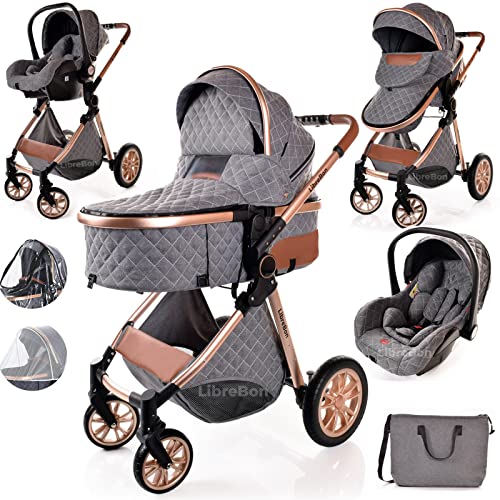The Comprehensive Guide to Choosing the Right Pram for Newborns
The arrival of a newborn brings both immense happiness and a range of choices that moms and dads need to navigate. One of the important purchases is choosing the right pram, which not just makes sure the baby's safety but likewise supplies benefit for moms and dads. This guide intends to supply an extensive check out picking the appropriate pram for newborns, talking about various types, features, security considerations, and upkeep pointers.
Understanding the Types of Prams
Prams vary commonly in style and functionality, which can be frustrating for brand-new parents. Here's a breakdown of the most typical types of prams available in the market:
| Type of Pram | Description | Pros | Cons |
|---|---|---|---|
| Traditional Prams | Created for babies, these prams usually have a deep bassinet. | Comfortable for newborns, Safe for sleeping. | Large and heavy, Hard to navigate in tight areas. |
| Travel Systems | A combination of an automobile seat and a stroller, permitting simple shift in between vehicle and stroller. | Versatile and practical, Cost-effective. | May be much heavier than standalone strollers, Not all parts appropriate for newborns. |
| Lightweight Strollers | Compact and simple to maneuver, these are perfect for moms and dads on the go. | Portable and simple to use, Generally more budget friendly. | Less cushioning, May not recline totally for newborns. |
| Convertible Strollers | Strollers that can adjust from a carrycot for newborns to a young child stroller. | Multi-functional and lasting, Adjustable setups. | Can be expensive, May need more maintenance. |
| All-Terrain Strollers | Developed for rough terrains, these strollers generally feature bigger wheels. | Long lasting for outdoor use, Stable on various surfaces. | Heavier and bulkier, Can be tough to guide indoors. |
Key Features to Consider
When choosing a pram for newborns, a number of features can significantly affect use and security. Here are important functions to bear in mind:
- Safety Harnesses: Look for a pram that includes a five-point safety belt to make sure the baby stays safe while in transit.
- Reclining Seat: A fully reclining seat permits newborns to lie flat, which is vital for their spine and respiratory health.
- Suspension System: A great suspension system supplies a smoother ride, vital for the delicate bodies of newborns.
- Brake System: Ensure the pram has a reputable brake system to prevent mishaps. Hand brakes or foot brakes can be effective alternatives.
- Storage Space: Consider a pram with ample storage area for diaper bags, shopping, or other essentials.
- Weight and Foldability: Choosing a lightweight option that folds easily is crucial for benefit, especially for mass transit.
Safety Considerations
Focusing on safety is paramount when it concerns prams for newborns. Here are vital security tips to guarantee the wellness of your baby:
- Check for Stability: Make sure the pram stays steady when stationary. A broad base can supply increased stability.
- Avoid Overloading: Only location products suggested by the manufacturer in the storage basket; excess weight can result in tipping.
- Regular Maintenance: Inspect the wheels, brakes, and harness systems consistently to guarantee they function effectively.
- Buckle Up: Always utilize the safety harness, even for fast journeys, to prevent the baby from slipping or falling out.
- Expect Age Recommendations: Follow the maker's guidelines regarding weight limits and age suggestions for security.
Maintenance Tips
Taking care of a pram guarantees its longevity and safety for your newborn. Here are necessary upkeep suggestions:
- Regular Cleaning: Wipe down the pram frame and wash materials according to maker instructions to keep it hygienic.
- Inspect the Wheels: Check wheels for damage and tidy them frequently to avoid obstructed motion.
- Examine Folding Mechanism: Ensure the folding mechanism operates efficiently without sticking or jamming.
- Oil Moving Parts: Apply the proper lube to moving parts to guarantee quiet and smooth operation.
- Store Properly: When not in usage, store the pram in a dry location to prevent rust and protect fabric integrity.
Often Asked Questions (FAQs)
1. For how long can a baby remain in a pram?
For newborns, it is typically recommended to limit undisturbed time in a pram to about 1-2 hours to prevent problems with development and flow.
2. Which pushchairsandprams is best for a newborn?
The best pram for a newborn is one that offers a completely flat recline, has an excellent security harness, and satisfies present safety standards. Many moms and dads choose travel systems for their adaptability.
3. Can I utilize a stroller without a cars and truck seat for a newborn?
It's suggested to use a stroller with a flat or near-flat recline for newborns. Some strollers are just appropriate from six months and up, so check the maker's assistance.
4. When should I change from a pram to a stroller?
You can move from a pram to a stroller when your baby can sit up independently, generally around six months, but this can differ. It's constantly best to consult the private pram or stroller standards.
5. What is the best way to clean my pram?
Always describe the maker's directions, but normally, you can clean up materials with moderate soap and water and clean down tough surfaces with disinfectant wipes.
Picking the ideal pram for a newborn is a substantial choice that impacts both the baby's convenience and the parent's way of life. By understanding the types of prams available, key features to consider, security strategies, and maintenance ideas, moms and dads can make educated decisions that boost their household's mobility and ensure the security of their children. Investing time in research now pays off in the long run for pleasurable trips and valued memories.

